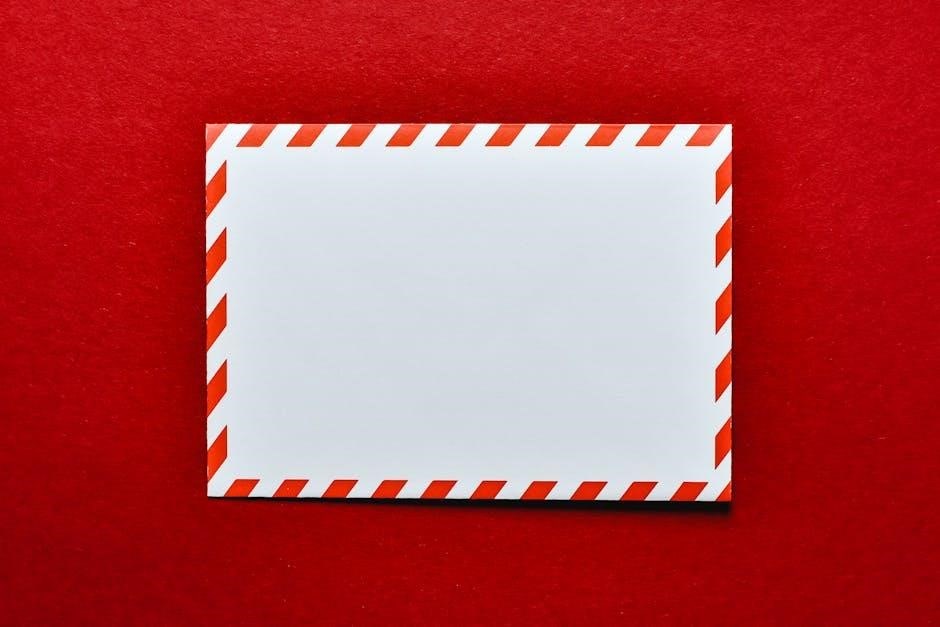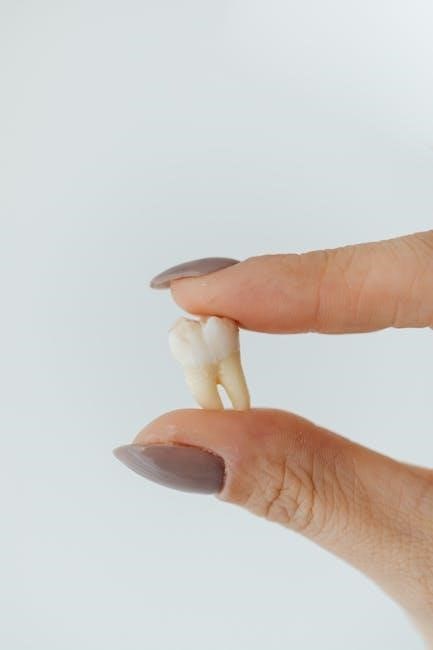Immediate Post-Operative Care
- Bite firmly on the gauze for 30-60 minutes to control bleeding. Replace if necessary, but stop if bleeding subsides.
- Avoid spitting, rinsing, or suction activities for 24 hours to protect the surgical site and promote healing.
1.1 Biting on Gauze
Immediately after the procedure, bite firmly on the gauze for 30–60 minutes to control bleeding. Replace the gauze if necessary, but discontinue once bleeding subsides. Avoid spitting, rinsing, or using a straw for the first 24 hours to protect the clot and ensure proper healing. Maintain gentle pressure to stabilize the surgical site and promote recovery. Follow these steps carefully to minimize complications and support the healing process effectively.
1.2 Avoiding Spit or Suction Activities
Refrain from spitting, rinsing, or using straws for at least 24 hours after the procedure. Avoid activities that create suction, such as drinking through a straw or vigorous coughing, as they can dislodge the blood clot. Do not rinse your mouth forcefully or spit out saliva, as this may disrupt the healing process. Instead, gently wipe your mouth with a clean napkin if needed. Keeping the surgical site undisturbed is crucial for proper clot formation and recovery. Adhering to this guideline minimizes the risk of complications and promotes faster healing.
Pain Management
- Take prescribed painkillers as directed to manage discomfort. Start with over-the-counter options if recommended.
- Monitor pain levels and adjust medication use accordingly. Contact your dentist if pain worsens or persists unusually.
2.1 Use of Prescribed Medications
- Take prescribed pain medications as directed by your dentist to effectively manage post-operative discomfort and inflammation.
- If prescribed, start with over-the-counter pain relievers like ibuprofen or acetaminophen, following the recommended dosage.
- Use narcotic painkillers only if necessary and as instructed to avoid dependency or side effects.
- Monitor your pain levels and adjust medication use accordingly, ensuring proper healing and comfort during recovery.
2.2 Monitoring Pain Levels
- Monitor pain levels closely after extraction to ensure comfort and proper healing.
- Assess severity and adjust medication use as needed, following prescribed guidelines.
- Report persistent or worsening pain to your dentist, as it may indicate complications.
- Track discomfort to determine if pain relievers are effective or if additional measures are required.
Dietary Recommendations
- Stick to soft foods and liquids for the first 24-48 hours after surgery to avoid dislodging the clot.
- Opt for cool or lukewarm foods to minimize discomfort and aid healing.
3.1 Soft Foods and Liquids
Following dental extraction, it is crucial to adopt a diet rich in soft foods and liquids to avoid disturbing the surgical site. Opt for items like yogurt, scrambled eggs, and smooth soups. Cold liquids, such as water or clear broths, can help reduce swelling. Avoid anything requiring chewing, as this can dislodge the blood clot essential for healing. Stick to a soft-food diet for the first 24-48 hours to ensure proper recovery and minimize discomfort.
3.2 Avoiding Hot or Carbonated Drinks
Hot or carbonated beverages should be avoided for at least 24 hours after the procedure. These can dislodge the blood clot, delay healing, or irritate the surgical site. Opt for cool or room-temperature liquids, such as water or clear broths, to stay hydrated without risking complications. Avoid using straws, as the suction motion can also disrupt the healing process. Resuming hot or carbonated drinks should only occur after the initial healing phase, typically within a few days, when the site is more stable.

Oral Hygiene
- Resume gentle brushing with a soft toothbrush 24 hours post-procedure, avoiding the surgical site to prevent irritation.
- Start saltwater rinses the day after surgery to keep the area clean and promote healing.
4.1 Resuming Brushing
Resume brushing gently with a soft toothbrush 24 hours after the procedure. Avoid the surgical site to prevent irritation or dislodging the blood clot. Use mild toothpaste and focus on cleaning other teeth thoroughly. Gradually increase brushing intensity over the next few days. This helps maintain oral hygiene without interfering with the healing process.
4.2 Saltwater Rinses
Start saltwater rinses the day after surgery to promote healing and reduce inflammation. Mix 1/2 teaspoon of salt in 8 ounces of warm water. Swish gently 2-3 times daily, focusing on the surgical area. Avoid vigorous rinsing to prevent dislodging the blood clot. Continue this routine for several days or as instructed by your dentist. Saltwater rinses help maintain cleanliness and support the recovery process without irritating the site.

Swelling and Bruising
Swelling is common after surgery, peaking around the second or third day. Apply a cold compress to minimize it. Bruising may appear as black, blue, green, or yellow due to blood under the skin, which is a normal post-operative occurrence.
5.1 Applying Cold Compresses
Apply a cold compress to the swollen area to reduce swelling and bruising. Use an ice pack wrapped in a cloth to avoid direct skin contact. Apply for 15-20 minutes every hour during the first 24 hours. This helps minimize swelling and discomfort. Continue as needed beyond the first day to aid in healing. Avoid pressing too hard on the surgical site to prevent further irritation or complications.
5.2 Expectation of Discoloration
Discoloration, such as black, blue, green, or yellow marks, may appear under the skin due to blood spreading beneath the tissues. This is a normal post-operative reaction and not harmful. Swelling typically peaks around the second or third day and gradually subsides. To minimize discoloration, continue using a cold compress as directed. The discoloration will fade naturally over time. Monitor the area and ensure no further irritation occurs. This is part of the healing process and should resolve without additional intervention.

Smoking and Alcohol
- Avoid smoking for at least 5 days after surgery, as it can delay healing and increase complications. Refrain from tobacco products during recovery.
- Do not consume alcohol for 24 hours post-procedure, as it can interfere with healing and interact with medications. Avoid carbonated and alcoholic beverages entirely.
6.1 Avoiding Smoking
- Smoking should be avoided for at least 5 days after surgery to promote healing and prevent complications.
- Nicotine and tobacco can delay recovery, increase the risk of infection, and reduce blood flow to the surgical site;
- Smoking can dislodge the blood clot, leading to dry socket, a painful condition that prolongs recovery.
- Avoid secondhand smoke as well, as it can also interfere with the healing process.
6.2 Avoiding Alcohol Consumption
- Avoid consuming alcohol for at least 24 hours after the procedure to ensure proper healing.
- Alcohol can interfere with blood clot formation, increasing the risk of bleeding and complications.
- It can also interact with pain medications, reducing their effectiveness and prolonging recovery.
- Alcohol thins the blood, which may delay the healing process and affect the surgical site.
- Refrain from alcohol during the initial healing phase to minimize risks and promote a smooth recovery.

Follow-Up Care
- Schedule follow-up appointments as directed by your dentist to monitor healing progress.
- Attend these appointments to ensure proper recovery and address any concerns promptly.
7.1 Scheduling Follow-Up Appointments
It is crucial to schedule follow-up appointments as directed by your dentist. These visits ensure the healing process is progressing as expected. Your dentist will monitor the surgical site for proper recovery and address any concerns or complications promptly. Regular check-ups help prevent infections and ensure the best possible outcome. By adhering to the recommended schedule, you support a smooth and effective recovery journey.
7.2 Monitoring Healing Progress
Monitor the healing progress by observing the surgical site for signs of infection, swelling, or unusual discharge. Ensure the area remains clean and follow the dentist’s instructions for post-operative care. Apply ice if swelling persists and maintain a soft diet to avoid irritating the site. Attend follow-up appointments to allow your dentist to assess the healing and address any concerns promptly. Proper monitoring ensures a smooth recovery and minimizes the risk of complications.
